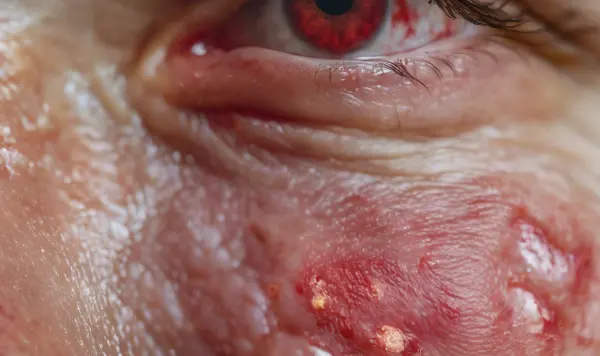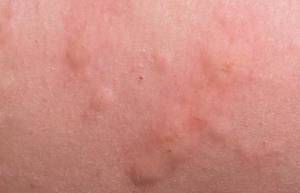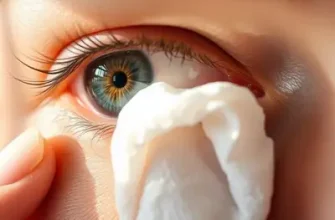The area around the eyes is highly sensitive and prone to developing rashes. A rash around the eyes can be uncomfortable, unsightly, and often accompanied by itching, redness, swelling, and even pain. It can be a result of various factors, such as allergies, irritants, eczema, or infections.
Allergic Conjunctivitis: Common Cause of Eye Rash
Allergic conjunctivitis is a common cause of eye rash that occurs when the eyes come into contact with allergens such as pet dander, pollen, or dust mites. This condition triggers an immune response that leads to inflammation and itchiness in the eyes.
When someone with allergic conjunctivitis is exposed to an allergen, their body releases chemicals, such as histamine, which causes the blood vessels in the eyes to become swollen and irritated. This results in redness, swelling, and a rash-like appearance around the eyes.
Symptoms of allergic conjunctivitis may include itching, watery eyes, a burning sensation, and increased sensitivity to light. The rash may also be accompanied by a clear, watery discharge.
Treatment for allergic conjunctivitis often involves avoiding the allergen that triggers the reaction. Over-the-counter antihistamine eye drops can help relieve symptoms, as well as applying cold compresses to reduce swelling and soothe the eyes. In more severe cases, a healthcare professional may prescribe stronger medications to manage the symptoms.
Contact Dermatitis: Irritant or Allergic Reaction
Contact dermatitis is another common cause of eye rash. It occurs when the skin around the eyes comes into direct contact with irritants or allergens. Irritant contact dermatitis develops when the skin is exposed to substances that can damage or irritate it, such as harsh chemicals or cosmetics. Allergic contact dermatitis, on the other hand, is a reaction triggered by an immune response to a specific allergen, such as certain metals, fragrances, or preservatives.
Symptoms of contact dermatitis include redness, swelling, itching, and a rash-like appearance around the eyes. In some cases, blisters or crusts may also develop. Identifying and avoiding the irritant or allergen that caused the reaction is crucial for managing contact dermatitis. Mild cases can often be treated by washing the affected area with gentle cleansers and applying a moisturizer. Over-the-counter hydrocortisone creams can help reduce inflammation and itchiness. In more severe cases, a healthcare professional may prescribe stronger topical corticosteroids.
To prevent contact dermatitis, it’s important to avoid known irritants or allergens, wear protective eyewear when necessary, and choose hypoallergenic or fragrance-free products.
Eczema-Related Eye Rash: Atopic Dermatitis
Eczema-Related Eye Rash, also known as atopic dermatitis, is a chronic skin condition that can affect the area around the eyes. It is a type of eczema characterized by inflamed, itchy, and dry skin. Atopic dermatitis is often associated with a family history of allergies or asthma.
Symptoms of atopic dermatitis around the eyes include redness, swelling, dryness, and intense itching. The rash can be triggered by various factors, such as exposure to environmental allergens, stress, or certain foods. Scratching the affected area can worsen the condition and lead to further complications, such as an infection.
Treatment for atopic dermatitis typically involves a combination of measures to relieve symptoms and prevent flare-ups. Moisturizers and topical corticosteroids may be prescribed to hydrate the skin and reduce inflammation. In severe cases, oral medications or immunosuppressive agents may be recommended.
To manage and prevent atopic dermatitis around the eyes, it is important to avoid irritants and allergens, keep the skin moisturized, and use gentle cleansers. Applying cold compresses can help soothe the itchiness.
Infections and Eye Rash: Conjunctivitis and Herpes
Infections such as conjunctivitis and herpes can also cause eye rashes. Conjunctivitis, also known as pink eye, is the inflammation of the conjunctiva, the clear tissue that covers the white part of the eye and inner surface of the eyelids. It can be caused by a viral or bacterial infection, or even an allergic reaction.
Common symptoms of conjunctivitis include redness, itching, tearing, and discharge from the eyes. Treatment for conjunctivitis depends on the underlying cause, and may include antibiotics for bacterial infections or antiviral medications for viral infections.
Herpes simplex virus (HSV) can also cause an eye rash known as herpetic keratitis. This viral infection can lead to painful sores on the eye, blurred vision, and sensitivity to light. Antiviral medication is typically prescribed to manage herpetic keratitis.
To prevent the spread of infections and reduce the risk of developing an eye rash, it is important to practice good hygiene, such as frequent handwashing and avoiding touching the eyes. It is also advisable to avoid sharing personal items, such as towels and cosmetics, with others. If an eye rash persists or worsens, it is crucial to seek medical attention for proper diagnosis and treatment.
Prevention and Home Remedies
To prevent and manage eye rashes, it is important to practice good hygiene and take certain measures at home. Here are some prevention tips and home remedies to consider:
- Practice good hand hygiene: Wash your hands frequently with soap and water, especially before touching your face or eyes. This can help prevent the spread of infections.
- Avoid rubbing or touching your eyes: Rubbing or touching your eyes can irritate them further and potentially lead to a rash. Try to refrain from rubbing your eyes, and if necessary, use a clean tissue or cloth instead.
- Use mild, hypoallergenic products: Opt for gentle and hypoallergenic skincare and cosmetic products. Harsh chemicals and fragrances can sometimes trigger an allergic reaction or irritate the skin around the eyes.
- Apply cool compresses: If you’re experiencing discomfort or itching, applying a cool compress to the affected area can provide relief. This can help reduce inflammation and soothe the skin.
- Avoid allergens and irritants: Identify and avoid potential allergens or irritants that may be causing the rash. This may include certain foods, pollen, pet dander, or specific skincare products.
- Seek medical advice: If the eye rash continues or gets worse even after using home remedies, it is important to consult a medical expert. A healthcare specialist can accurately identify the root cause and prescribe suitable treatment.









